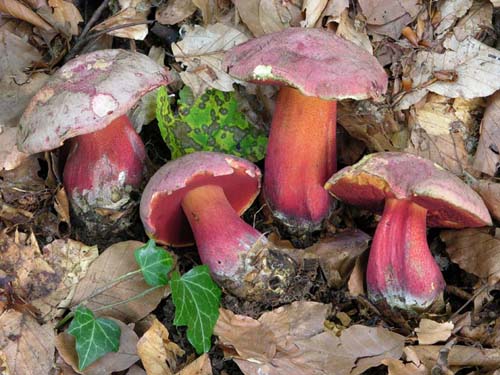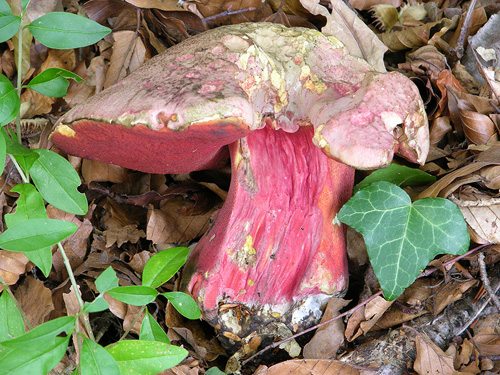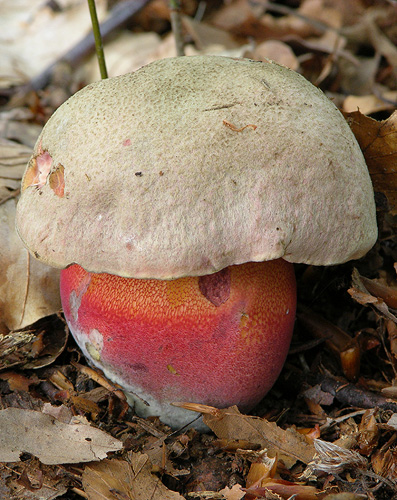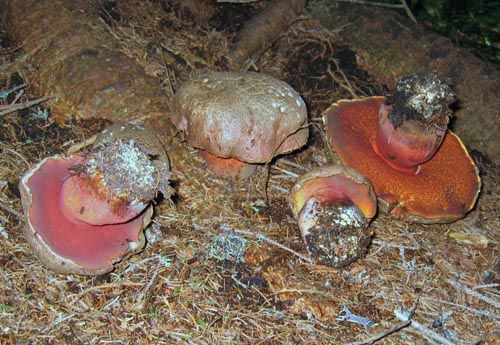Boletus L.
Recent molecular studies have shown that Boletus in its current circumscription is likely an artificial grouping and it is possible that it will be split at some point into smaller genera. Note that Boletus impolitus and Boletus depilatus for practical reasons are retained here, although there is strong evidence that they are closely related to Xerocomus subtomentosus and its allies.
Fruitbody large to medium sized, boletoid, without veil and ring. Stipe solid, with surface usually covered with granules or network. Flesh variously coloured, changing or not when exposed to air. Tubes easily separable from each other, not tearing apart. Pores usually small and rounded.
Boletus rubrosanguineus Walty ex Cheype
Description
Cap up to 15 cm, at first hemispherical, later convex to flat-convex, smooth, at first almost silvery grey, greyish to dark grey, greyish brown, with pinkish tint at the cap margin, the pink hue gradually developing throughout to entirely dingy pink, dark pink or pinkish vinaceous, surface unchanging when bruised. Stipe club-shaped or cylindrical, in the uppermost part bright to dark yellow, downwards orange red to red, pinkish red or dark red, with fine orange red or red to dark red network, stipe surface blueing when handled. Flesh pale yellow, sometimes with reddish spots in the stipe base, blueing when exposed to air. Tubes yellow, blueing when injured. Pores red to blood red, blueing when bruised. Smell of hay, persistent when the fungus is dried. Taste slightly acid. Spores 10–14.5 × 4–6 μm, ratio 2–3.1. Pileipellis trichodermium of interwoven septate hyphae of cylindrical, finely incrusted cells. Chemical reactions: hyphae of the flesh in the stipe base inamyloid with Melzer’s solution.
Habitat. Mountain coniferous forests, mycorrhizal with spruce (Picea) or fir (Abies).
Distribution. Not yet fully understood; in the east reaching Caucasus.
Similarity. Boletus legaliae is very similar, but is found in different habitat.
Photographs

Fruitbodies of Boletus rubrosanguineus in different stages of development. Note the colour variability reminding the one seen in Boletus legaliae. (photo M. Danz)

Mature fruitbody of Boletus rubrosanguineus. (photo M. Danz)

Young fruitbody of Boletus rubrosanguineus. The network covering the upper parts of the stipe is well seen. (photo M. Danz)

Young fruitbody of Boletus rubrosanguineus. Note the paler cap colour characteristic for the young fruitbodies of this bolete. (photo M. Danz)

Mature fruitbodies of Boletus rubrosanguineus. (photo A. Grozdanov)
Important literature
Alessio, C.L. 1991. Supplemento a Boletus Dill. ex L. (sensu lato). – In: Fungi Europaei. Vol. 2A. Pp. 1–126. Libreria editrice Biella Giovanna, Saronno.
Breitenbach J. & Kränzlin F. 1991. Pilze der Schweiz. Bd. 3(1). Röhrlinge und Blätterpilze. Verlag Mykologia, Luzern.
Engel, H., Krieglsteiner, G., Dermek, A. & Watling, R. 1983. Dickröhrlinge. Die Gattung Boletus in Europa. Verlag Heinz Engel, Weidhausen b. Coburg.
Estadès, A. & Lannoy, G. 2004. Les bolets européens. – Bulletin Mycologique et Botanique Dauphiné-Savoie 44(3): 3–79.
Galli, R. 1998. I Boleti. Atlante pratico-monographico per la determinazione dei boleti. Edinatura, Milano.
Knudsen, H. & Vesterholt, J. [eds.]. 2008. Funga Nordica. Nordsvamp, Kopenhagen.
Lannoy, G. & Estadès, A. 2001. Les Bolets. Flore mycologique d’Europe. Documents Mycologiques Mémoire Hors série no. 6. Pp. 1–163. Association d’Écologie et de Mycologie, Lille.
Muñoz, J.A. 2005. Boletus s. l. – In: Fungi Europaei. Vol. 1. Pp. 1–951. Edizioni Candusso, Alassio.
Singer, R. & Kuthan, J. 1976. Notes on Boletes. – Česká Mykologie 30: 143–155.
Šutara, J., Mikšík, M. & Janda, V. 2009. Hřibovité houby. Čeled’ Boletaceae a rody Gyrodon, Gyroporus, Boletinus a Suillus. Academia, Praha.